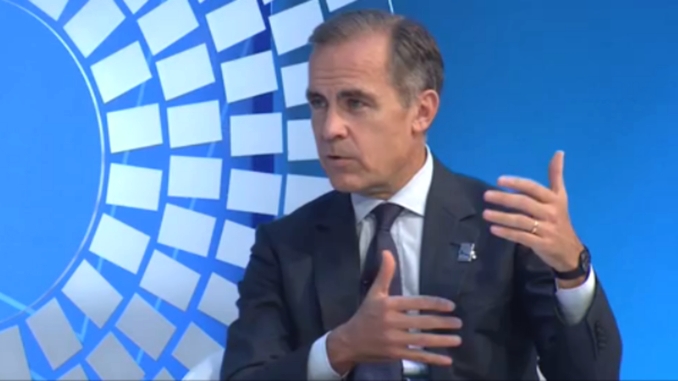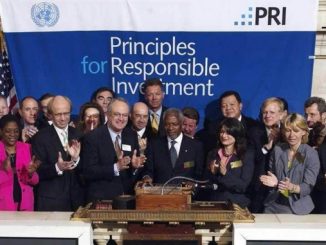
Buyers of green bonds are potentially receiving climate-related credit protection for free, Bank of England governor Mark Carney highlighted at the World Bank/IMF Annual Meetings yesterday (Saturday), but he said prudential regulation should not be used as a “backdoor” for climate policy.
Participating in a Per Jacobsson Foundation panel, Economic & Financial Issues Related to the Impact of Climate Change, Carney – who is also chairman of the Financial Stability Board (FSB) – was asked if he shares a view floated by the Dutch central bank (DNB) that a green bubble could emerge.
“Never say never,” noted Carney, but he played down such a possibility in the maturing market.
“In any market, you’ll always get overshoots, undershoots, euphoria, despair,” he said. “I think what we are seeing in climate markets – and this is not investment advice – is a learning process, the very early stages of a learning process. And again, what you want in a market is people who are techno-optimists and pessimists, people who are true believers or doubters, evangelists or not, and that is what makes a market. They need the information in order to make the market – they are getting it.
“If you look at the pricing in, say, green bonds, you are getting green for free now basically,” he added. “So – because of standardisation – you are basically getting a capital markets instrument that actually gives you this additional benefit – which if you have a view that the climate policy framework’s going to tighten over time, actually gives you some protection in terms of the underlying credit – you are getting that for free right now.”
His comments on pricing referenced earlier thoughts from Ashley Schulten, head of responsible investing, global fixed income, BlackRock, who deemed progress on this front to be key to unlocking further growth.
“If we can get a little bit of a pricing tension for good green bonds out there, that changes the way companies think about allocating capital internally,” she said. “I think there is huge potential for this market.”
Schulten said this is possible on the back of the progress the green bond market has made, particularly in standardisation.
“This conversation always comes up, you know, why we only have $260bn now and that’s really only a drop in the bucket,” she said. “But we need to remember that this is a market that is about four years old, really, and four years ago when we started this I never would have dreamed that we would have sovereign issuers, S&P and Moody’s rating this, making it valid as an asset class, thinking about global labels. I mean, it’s incredibly powerful the potential here, and if we can work to a place where we do have enough global standardisation…
“And I have to say honestly, standardisation is last year’s conversation, because we are really at that point where most green bonds that come, I would say 95% of the green bonds that I look at, they conform to the Green Bond Principles and are green enough.”
At the FSB Carney has been involved in recommendations from the Task Force on Climate-related Disclosures (TFCD), and in respect of both these and green bonds he said standardisation should be market-led, agreeing with Schulten, who had noted that her firm’s progress in examining companies’ disclosures and scenario planning “is happening at Mach 10”.
“If some things are moving at Mach speed,” said Carney, “you don’t necessarily have to reinforce it.”
He had earlier noted the Bank of England’s work with international public bodies such as the People’s Bank of China and also work with the financial industry on green bond standards and certification.
“It’s now more in the hands of industry to take that final step through again,” said Carney, “and if there’s a common theme here, the market is going to decide what works for the market.”
However, while the governor is not intending to use a stick to impose green bond standards, neither is the carrot of capital relief for green bonds or underlying assets on the agenda, according to Carney.
“The core point that we have been making on prudential regulations is that you don’t use them as backdoor climate policy,” he said when asked if lower capital requirements could be introduced for green assets. “And so you’re making a judgement if you are lending to a CCGT (combined-cycle gas turbine) plant in China versus a coal plant, or solar here versus coal, for example.
“You as the credit provider have to make your own judgement about the future policy environment, not have the bank regulator make a judgement for you. And that’s, again, the reason why we want to get the proper information, so I wouldn’t advocate using prudential regulation.”
Sean Kidney, CEO of the Climate Bonds Initiative, asked from the audience if the Bank of England would be open to introducing capital relief for some green assets if quantitative evidence is provided by project such as the EMF-ECBC-led Energy efficient Mortgages Action Plan (EeMAP).
Carney acknowledged that “directionally, you are right”, but stressed the importance of performance history.
“And so from a capital relief perspective you need to have enough of a life-cycle history and it’s at a relatively early stage, so for a prudential regulator, there’s just not enough of a performance history yet to give capital relief,” he said.
He nevertheless noted that capital providers might pick up such assets in anticipation of outperformance resulting from a possible future regulatory benefit. He also said that the G20 is looking at securitisation and covered bonds as another “wedge” of potential green financing.
Schulten meanwhile said that other public measures could play a role in supporting the green bond market.
“Of course we don’t want to introduce anything that would introduce risk to the financial system,” she said. “But I will say that, as all of you here hear, there is enormous conversation around the public/private partnership, and how can public capital pull in the trillions of private capital that we need to fund the low carbon transition.
“And here’s the green bond market that is basically a private sector initiative that is succeeding. And to the extent that we can get standards, we would ask for some sort of public support. I don’t know what form that public support takes, in terms of it is a tax incentive, is it encouragement of public money to invest in these? But I surely see that that there is an opportunity where we could have some partnership that would help further the market.”
Photo credit: IMF



